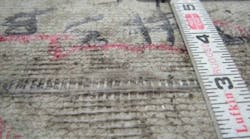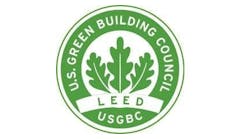A roofing file for each building or sector under your control is vital for roof maintenance. This valuable source of information provides the context you need to plan for preventive care, repairs with compatible materials, and eventually, re-cover or re-roofing. If your roofing file doesn’t already include product labels for each of the roof components, now is a good time to start adding them. This step may seem redundant, but can prove useful down the road.
Single-Ply Specimens and Legible Labels
Over the last 10 years, single-ply roof membranes have to a great extent displaced traditional bituminous (BUR) systems for both new roofing and re-cover applications. Much of this displacement is due to the rapid growth of the new kid on the block, thermoplastic polyolefin (TPO) roof membranes. And, like many “new” products before it, there have been growing pains.
Most TPOs performed quite well but some did not, and those that did not failed in quite dramatic fashion. Why? A lot of excitement, and some misinformation, was generated around earlier failures. But the science needed to understand what was really going on didn’t start to emerge until physical and chemical comparisons could be made between specimens of TPO sheets exhibiting advanced weathering and specimens of the original “unweathered” TPO sheets – which, by the way, were few and far apart. It turned out that membrane thickness and some fairly subtle differences in the types, percentages, and “dispersion” of UV- and heat-stabilizing agents made all the difference between TPO membranes that performed well and those that started to look like cheesecloth, in spots, after 8 to 10 years.
So, what does this teach us? It is a good idea to collect fresh specimens of any membrane and place them in zippered folders that are secured in the roofing file. This allows you to compare the original material to a weathered version later – formulation mistakes do happen and comparison with an unweathered sample is the only way to properly diagnose that issue. ASTM D6878 requires a minimum coating of 0.015 inches over the fabric or scrim. If the fabric is visible due to scuffing or erosion, early failure is probable. Be sure to date each roofing membrane sample and add the name and phone number of the installer.
Richard (Dick) L. Fricklas, received a Lifetime Achievement Award and fellowship from RCI in 2014 in recognition of his contributions to educating three generations of roofing professionals. A researcher, author, journalist, and educator, Fricklas retired as technical director emeritus of the Roofing Industry Educational Institute in 1996. He is co-author of The Manual of Low Slope Roofing Systems (now in its fourth edition) and taught roofing seminars at the University of Wisconsin, in addition to helping develop RCI curricula. His honors include the Outstanding Educator Award from RCI, William C. Cullen Award and Walter C. Voss Award from ASTM, the J. A. Piper Award from NRCA, and the James Q. McCawley Award from the MRCA. Dick holds honorary memberships in both ASTM and RCI Inc.
Read the Label!
UL logos assure us that the material has been tested for fire and/or wind resistance. Listing in the UL Roofing Materials & Systems Directory reminds us that the entire system, not just the membrane material, must be tested. You are probably familiar with the UL fire ratings as Class A, B, or C, where Class A roof coverings are “effective against severe fire exposure,” B coverings are “effective against moderate fire exposure” and C means “effective against light fire exposure.”
The logo of FM Global (formerly “Factory Mutual”) is best known in the roofing industry for Class 1 steel deck assemblies and noncombustible decks (concrete, gypsum, asbestos cement, preformed structural mineralized wood fiber, and wood decks treated with fire-retardant inorganic salts limiting flame spread to 25 feet or less).
Both FM and UL provide third-party quality assurance, either by inspecting production at the roofing company’s factory or randomly selecting warehouse specimens to test for compliance.
For wind resistance of shingles, ASTM 3161 defines Class A at 60 mph, Class D at 90 mph, and Class F at 110 mph.
FM publishes lists of approved compact roof deck assemblies under Building Materials and Construction, and UL lists rated assemblies as Class 30, 60, or 90 (psf). FM test devices may be 5- by 9-foot or 12- by 24-foot pressure chambers.
What Else Can Labels Tell Us?
Other information provided on packages of roofing material includes code compliance, regional information, ICC-ES, UBC, Florida approvals, and the like. Particularly important is information about Code Compliant Edge Attachment (which minimizes risk of blow-offs) that must follow ANSI/SPRI ES1 requirements.
Most manufacturers provide a time code that includes when and where the product was produced. This is helpful in tracking down a product that may be out of specification. Some product labels might indicate recyclability or certification for low VOC emissions.
Commercial Roof Maintenance: A Proactive Approach
Keep roofing costs down with smart preventive measures.
4 Tips for Pest Control on Green Roofs
Maintain vegetation without an invasion.
The Staying Power of Modified Bitumens
Why asphalt-based roofing materials maintain their popularity.


